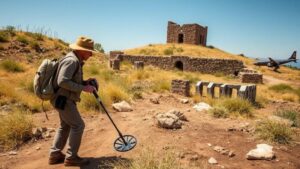Exploring ancient legends of serpent-filled tunnels beneath desert ruins.
Exploring Ancient Legends of Serpent-Filled Tunnels Beneath Desert Ruins
Throughout human history, myth and reality have interwoven to create fascinating tales that capture the imagination. Among these tales, the legends of serpent-filled tunnels beneath ancient desert ruins are particularly captivating. This article delves into the mystery surrounding these tunnels, exploring their historical context, cultural significance, and the tantalizing evidence that may link these legends to real-world discoveries.
Historical Context of Serpent Legends
The lore of serpents is prominent across various cultures, with the serpent often symbolizing wisdom, death, and rebirth. In ancient Mesoamerican civilizations such as the Aztecs and Mayans, deities like Quetzalcoatl, the feathered serpent, represent a dual nature of creation and destruction. Similar themes can also be found in Egyptian mythology, where the serpent goddess Wadjet played a crucial role in protecting the pharaohs.
The legends of tunnels filled with serpents are often tied to ancient ruins. For example, the Great Pyramid of Giza, built around 2580-2560 B.C., has long been rumored to have hidden passageways and chambers. While most of the pyramids interiors are well-documented, the allure of undiscovered tunnels persist, fueled by the belief that ancient knowledge and treasures may still reside within.
Tales from the American Southwest
In the American Southwest, Native American tribes tell stories of vast underground networks, sometimes inhabited by serpentine beings. The Hopi tribe, for example, speaks of the “Sasaquatch,†a creature akin to a serpent that emerges from underground realms. Archaeological evidence suggests that the Hopi and nearby Puebloan peoples may have had connections to ancient structures such as Chaco Canyon, with its complex system of roads and kivas.
The Chaco Culture National Historical Park, designated a UNESCO World Heritage site in 1987, features impressive stone buildings constructed between A.D. 900 and 1150. Some researchers theorize that the system of roads might connect to subterranean tunnels. While solid evidence linking these legends to specific tunnels remains elusive, the cultural context enriches the narrative and underscores the significance of these beliefs.
Legends Across the Globe
Legends of serpent-filled tunnels are not restricted to one region but occur across the globe. For example:
- Middle Eastern Legends: In the deserts of Saudi Arabia, tales of Jinn, often depicted as snake-like beings, suggest the existence of underground passages connected to ancient civilizations like the Nabateans, known for their rock-hewn city of Petra.
- South American Myths: The Amazonas region is rich with stories of the “La Llorona,†a serpent woman who is said to guard entrances to mythical underground realms that hold vast treasures.
- European Folklore: In Celtic mythology, stories of the “Serpent Mounds†in England connect to beliefs about purification and the protection of sacred sites.
Scientific Exploration and Discoveries
While many of these legends are steeped in myth, scientific exploration has uncovered substantial evidence of underground structures. For example, in 2018, archaeologists in Egypt discovered extensive tunnel networks beneath the Temple of Karnak, some dating back to 2000 B.C. These tunnels, though not filled with serpents, demonstrate that ancient civilizations often constructed elaborate subterranean systems.
In 2020, archaeological studies in the Nazca Desert of Peru revealed traces of underground aqueducts, supporting theories about advanced engineering systems that could have played a role in local mythologies surrounding serpents and water deities.
Challenges and Skepticism
While the legends are enchanting, skepticism remains regarding their authenticity. Critics argue that many of these tales could be products of oral tradition rather than historical realities. Also, the process of validating such underground passageways is fraught with challenges, particularly in terms of access and preservation.
Plus, contemporary scientific methods, such as ground-penetrating radar and drone surveys, are yet to locate definitive evidence of serpent-filled tunnels in many regions. These techniques, while promising, often yield inconclusive results when searching for specifically described mythological constructs.
Conclusion and Actionable Takeaways
The exploration of ancient legends regarding serpent-filled tunnels beneath desert ruins offers a compelling intersection of history, culture, and mythology. While concrete evidence remains sparse, the rich tapestry of stories across various civilizations opens avenues for further research and exploration.
As we continue to dig into the Earth’s depths, here are some takeaway points for those intrigued by these legends:
- Consider visiting archaeological sites, such as Chaco Canyon or the Great Pyramid, to experience the history and culture firsthand.
- Stay informed on new archaeological discoveries and studies, as technology continues to change our understanding of ancient civilizations.
- Engage with local folklore and community narratives, as they may reveal deeper insights into the cultural significance of legends tied to ancient ruins.
The mysteries of our past linger, waiting to be unveiled–perhaps one day, the legends of serpent-filled tunnels will transition from myth to reality.



